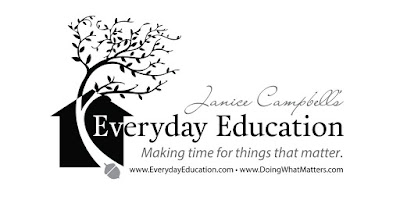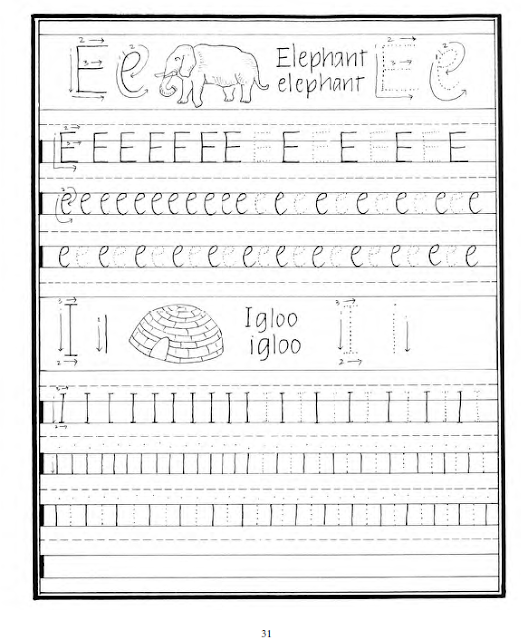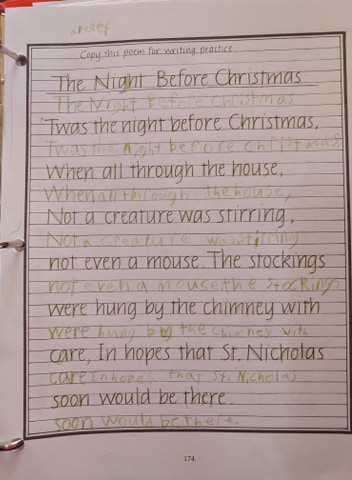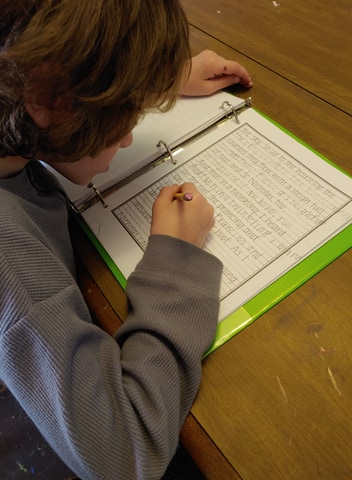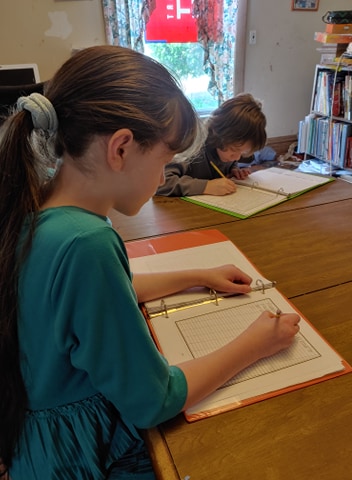We had the opportunity to review the Perfect Reading, Beautiful Handwriting ebook from Everyday Education, LLC. The part that caught my attention was the "beautiful handwriting" part of the title. Seeing as my children are all reading chapter books at this point, I figured we wouldn't require the reading instruction section of the book. However, while I was researching the book prior to asking to review it, I learned that one of the ways to use the book is "to teach children to have fast, legible, attractive handwriting." And this was definitely something I wanted the children to work on as they do struggle with neatness.
We received the downloadable PDF file of Perfect Reading, Beautiful Handwriting. However, the book is also available as a print version. With multiple children needing to use it, I was thankful for the PDF file that could be printed as many times as we needed it for our family.
This 218-page book was originally published 20 years ago by Caroline Joy Adams. In the forward, we learn that Janice Campbell, with Everyday Education, had used the book with her oldest son and appreciated the simplicity and the clear penmanship. Unfortunately, when it came time for her to use it with her second child, the book was out of print. Though she ended up using other resources, she was never as satisfied as she was with Perfect Reading, Beautiful Handwriting, so she worked on bringing it back into print.
Also in the forward, Janice Campbell explains how to teach the lessons, bringing up the importance of proper posture and pen hold. She also discusses spacing, slant, rhythm, and size, plus using it with Model-Based Writing. She also shares scheduling options and discusses making reading an important part of everyday life.
Next you will find an introduction by the author, Caroline Joy Adams. First there is a current introduction where she expresses her delight in having the book being released in a new edition. She goes on to discuss the importance of physically writing by hand and the pleasures of creating works of art with writing and calligraphy. Something that has been lost in this electronic age. Then you will find the list of four ways to use the book, written by the author back in 1998. They are:
- To teach young children how to read and write.
- To teach children with reading difficulties to read effectively.
- To teach children to have fast, legible, attractive handwriting.
- To teach yourself beautiful handwriting.
I chose to use the book to work on improving Hannah and Harold's handwriting.
The majority of the book is devoted to the actual reading and writing program. Each of the 60 lessons is usually two pages in length and is meant to take one day (as seen in the subtitle of the book: "The Intelligent Parent's Complete Step-by-Step Program for Teaching Any Child How to Read & Write in 60 Days!"). Though we aren't using the learning to read portion, I have looked through it, and I do wonder if I would have taken longer for each lesson when my children were learning to read. As we aren't using it, I can't speak to how my children would have done with it as laid out, but I feel it may progress a little too fast and expect a bit more writing than my children would have been able to do per day at that age.
Let's look at each of the chapters.
Chapter One explains the method used to teach reading and writing in the book, along with teaching tips. I appreciate that a phonic method is used, where she teaches sounds and blending. This is the way I taught my children. I love that she brings up that the English language does sound the way it is spelled 87 to 94 percent of the time, and there is only a 10 percent exception to the rules. In addition to discussing the phonics rules and the exceptions, the author talks about the right age for a child to learn to read. As I used to work in a Montessori, I was thrilled that she brought up Maria Montessori's finding about "sensitive periods" in a child's life, and the importance of catching a child during this time. For learning to read, this would be between the ages of four and six. Though she admits there are exceptions. She even addresses opposition from the "experts." There is quite a lot of interesting and important information in the first chapter of this book.
Though we didn't use the learning to read sections of the book, I did want to share a bit about it.
Chapter Two focuses on the alphabet. The student is taught the italic form of writing. The reason for using the italic form is also discussed back in chapter one. Each page has a child work on two different letters, both capital and lowercase, starting with the vowels first.
Chapters Three, Four, and Five teach a child to read using the phonic method. The format of the book remains the same as the child works through the lessons. First a list of words is given that focus on the sounds that are being learned.
Then the child is given writing practice using words that have been learned.
As new sounds are learned, they are added in with the writing practice.
The lessons in chapter three progress from short vowel sounds, to consonant blends, then to plural words, "compound" words, to magic e words, magic e exceptions, words with the "or" sound, and short words ending in vowels.
Chapter four moves on to vowel combinations and special sounds. Chapter five then moves into silent letters, other sounds, endings, contractions, common exceptions, important words to know, numbers, and the 500 most common words.
Chapter Six is the chapter we have been working in. This is the Handwriting Practice section. The author first shares different ways that italic writing can look, and information on using the chapter. There is then a page to practice writing the letters. I had the children start with this.
The children then got to practice by writing out "The Night Before Christmas."
I discovered that they can only work on a few lines at a time before their writing gets messy. Especially because I will have them go and redo it if it isn't to my satisfaction, so we are taking longer than I thought we would to get through the handwriting practice.
Partway through the poem, the author switches to slanted letters, though the children and I don't see a huge difference. I do think the slanted lines have actually made it a bit trickier for Hannah when she tries to write, because she can't really see how it is that different.
Hannah finally made it to the end of the poem.
And she got to write a little bit of information about herself.
After this section, which concludes with a sheet which can be used for writing practice in the slanted style. A child could choose to write a funny story or other writing assignment.
Chapter Six continues by teaching the student to write in a smaller size and to learn which letters should and shouldn't be joined while writing in italic. I think before moving onto this section, we are going to back up and use some of the writing from the learning to read section. Even though the children know how to read, I have realized that we could use this section as spelling practice. I plan to go through the list, asking the children to spell the words. If there are any they struggle with, I will have them write from that section. I am also choosing to do this because I feel they could use the extra practice forming the letters.
As they improve in their handwriting, we will then move onto the section that uses an edged, or calligraphy pen. I remember learning to write in calligraphy in junior high, and think it would be fun for the children to learn. Honestly, I'd love to have a go at it myself. There are several pages of practice with different variations, some I have never seen. I may even be able to convince at least one of the older girls to try the calligraphy style. Perhaps Tabitha as she is my artist.
I honestly feel that this reading and writing curriculum has some pros and cons. If a child has already learned how to form letters the traditional print way, they may struggle to form the italic letters. I know my kiddos are. Even when they are trying their best to write neatly, the form is closer to what they have learned all these years. Additionally, although the author mentions that the traditional way of printing uses a lot more strokes than italic, I have noticed that my children (and myself) already write the letters the way she shows in italic, except as I mentioned it doesn't' have that italic look. I can see this book working better for children who haven't had any instruction in print writing.
I also think the slanted lines are a bit confusing for Hannah, as I mentioned above. She definitely seems to prefer writing straight up and down. I think we will practice a bit more with the funny sentences in the learning to read section, as I mentioned above. And then we will try the slanted style again.
I did just want to mention that I was a bit confused about the fact that on a lot of the pages the last line can not be written unless it is just traced, seeing as the last line of text is on the very last line. Also, I am confused about the author's use of the word "compound words" seeing as out of the page of 48 words, only around 8 of them are actual compound words.
So, there are some things that I can see work really well in this curriculum, but there are a few things, as I mentioned above, that make me hesitant to highly recommend the book.
Don't forget to click on the banner below to see what my fellow Crew Mates thought about this ebook.



